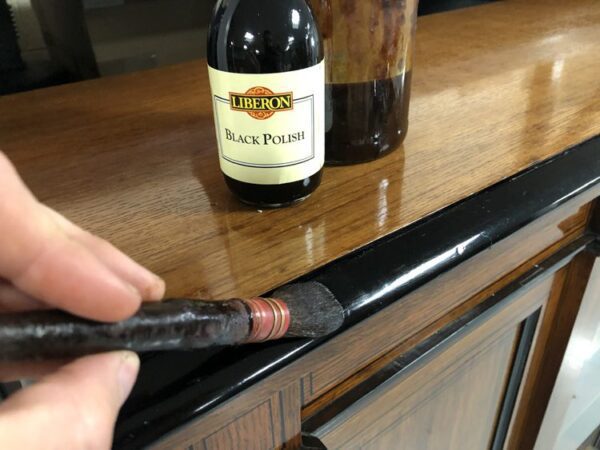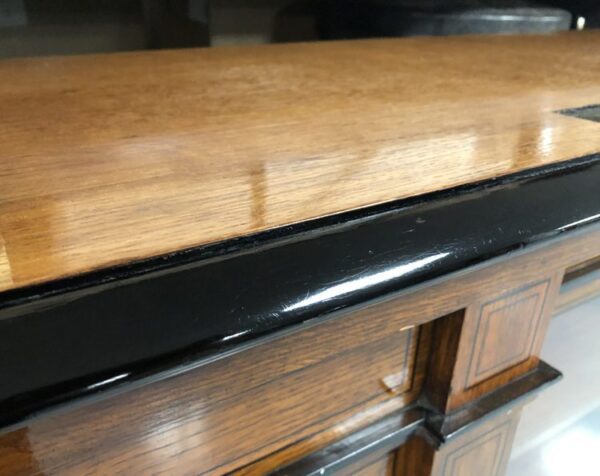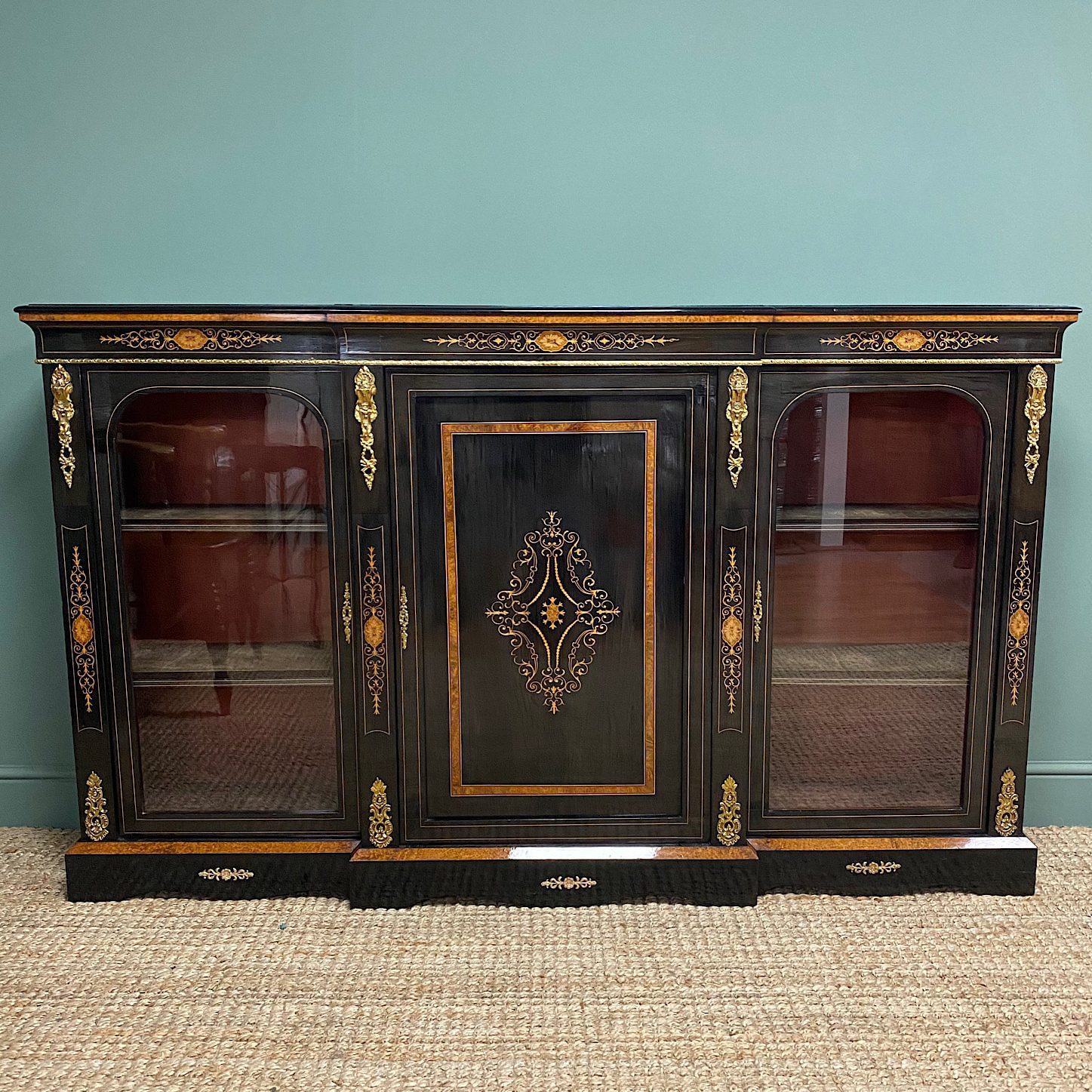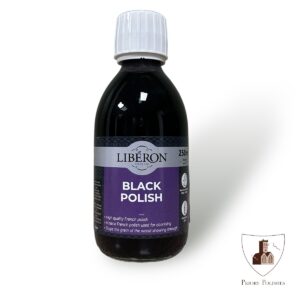Ebonizing wood furniture was very popular in the late 19th Century especially during the Arts and Crafts Movement. The process to Ebonise wood was a technique used by French polishers to produce a very dark or black finish to resemble the very dark and expensive timber Ebony. Ebonizing furniture actually originated in much earlier times, seen as far back as the 16th century in Jacobean furniture.
How to Ebonise Wood using Liberon Black Polish
Liberon have produced a very simple and easy to use product called Black polish. Liberon Black Polish is a high quality stained French Polish, that stops the grain of the wood showing through. It can be applied with a soft bristled polishing mop or with a polishing rubber in the same way as traditional French Polishing techniques.


When working with any finishes but especially French Polishes, always apply in a warm, clean, dry, dust-free environment.
1. The first thing to do is ensure the wood has no previous finish and is bare wood. You can remove any previous painted or varnished finish back to the bare wood by using a wood stripper and then lightly sand using a fine sanding paper. Fill any holes and chips in the wood using Ebony Liberon Wax Filler Sticks. Excellent preparation is very important as black polish will bring up any visible surface defects as it will be a dark glossy finish.
2. Once all finishes have been removed back to bare wood, Stain the wood using Ebony Liberon Palette Wood Dye. You can also add Black Liberon Water Based Concentrate Dye to make a very dark stain. The idea is to get the bare wood as black as possible. Apply the stain with a brush, cloth or foam applicator but ensure you wipe off any excess and allow drying thoroughly (preferably overnight).
3. Next, seal in the stain and build up the depth of colour and sheen using Liberon Black Polish. For the first coat, I would recommend to apply using a French polishing brush as this will add a good seal coat. You can then apply using the same method or for a smoother finish use a French polishing rubber. Use the French polishing mop or fine brush on more ornate pieces, such as carvings etc.
4. After the first two coats of Black Polish, allow to dry for several hours or over night and then lightly rub down using Liberon Ultra Fine Steel Wool (0000) or very fine sanding pads. Dust off any excess ready for the next coat.
5. Apply further coats of the Black Polish to build up the sheen, rubbing down between coats if necessary. Ensure you always dust between coats as dust can settle on the surface.
6. If a high gloss finish is required then allow the Black Polish to harden for at least ten days and the lightly rub down using ultra Fine Steel Wool (0000) and burnish with Liberon Burnishing cream.
7. For best results always finish with a good quality dark Wax finish as this will further enhance the wood and add a layer of protection to your furniture. You can then re apply wax whenever needed in the future to add a shine and protect further.
Important advice on Ebonizing
If you start experiencing any problems whilst using this polish, then the best advice is to stop and asses. Allow the polish to harden fully, rub back the error and restart from that point. Below are some common problems that can occur when ebonising wood so follow the instructions below to help you get a nice even finish.
If Ripples appear on surface then, too much polish has been applied. Allow the polish to fully dry and then lightly sand the surface back to a smooth flat finish and then continue. If the ripples are really prominent you may have to sand back and re-start.
If the Polish appears to have been removed by the polishing rubber then this has been caused by too much pressure. Allow the polish to harden then cut back and restart. Sometimes you can lightly cut back with 0000 wire wool and re coat unless the stain has been removed also.
If there is Bloom to the polish or it has a milky film on the surface, this is caused by dampness in the air or on the surface. Allow the polish to fully dry and harden, then first try to burnish using polish reviver. If this does not work then pad the surface back with sandpaper and then restart.
If Finger marks appear when you touch the polished surface, then the polish has not had time to harden before being handled. Allow the polish to harden, cut back with Ultra Fine Steel Wool (0000) and then either re-apply a coat of French polish or burnish with Burnishing Cream.
If the Polish will not dry, the most common cause for this is that the French polish is too old. Discard the polish and start with a fresh batch. Once the bottle has been opened, it usually only lasts around six months but ensure you re-attach the lid between uses.





4 Comments. Leave new
Hi, this is more of a question than a comment, hope that’s okay. is it possible to use this method on Tulipwood {Poplar} and would you get that deep shiny black finish. or would you get a better result using black paint, maybe a matt with a gloss lacquer.
Hi
Yes you can use this method on almost any wood and you would achieve a deep shiny finish with the more coats you apply.
I hope this helps
James
Can I apply Liberon black polish over a very old ebony desk I do not wish to take it back to the Bearwood due to all the intricate gilding I look forward to your reply.?
Hi, Thank you for your message. With this product, you do usually need to apply this on to bare wood in case of any reaction to the existing finish. You could try using the Black Touch Up Grain Pen, but always test in a small inconspicuous area before use. I hope this helps 🙂
Kind regards, Isabel @Priory Polishes